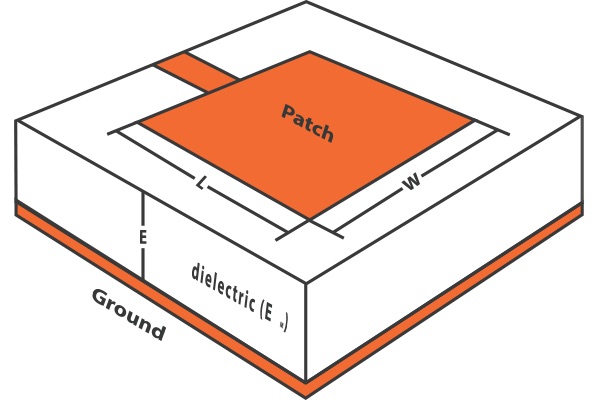This tool calculates the dimensions of the microstrip patch antenna given the desired operating frequency.
Outputs
Overview
A microstrip patch antenna is one of the most popular microwave antennas. This tool is designed to calculate the correct dimensions of a microstrip patch antenna if the operating frequency and the dielectric constant of the material used, is known. If the dielectric constant of the material is not known, you can choose to put in the velocity of propagation of the signal instead.

The length and width of the microstrip patch antenna can be calculated using the formulas below.
Equations
$$W = \frac{c}{2f_{0}\sqrt{\frac{\epsilon_{R}+1}{2}}}$$
$$L = \frac{c}{2f_{0}\sqrt{\epsilon_{eff}}}-0.824h\left(\frac{(\epsilon_{eff}+0.3)(\frac{W}{h}+0.264)}{(\epsilon_{eff}-0.258)(\frac{W}{h}+0.8)}\right)$$
Where:
$$W$$ = width of the microstrip patch antenna
$$L$$ = length of the microstrip patch antenna
$$\epsilon_{R}$$ = dielectric constant
$$\epsilon_{eff} = \frac{\epsilon_{R}+1}{2} + \frac{\epsilon_{R}-1}{2}\left[\frac{1}{\sqrt{1+12(\frac{h}{W})}}\right]$$
Applications
In recent years, the use of microstrip patch antennas have increased because of the inherent advantages. Together, with the increasing number of its users is the continuation of developing the method for more applications.
Microstrip patch antennas gains an advantage over other microwave antennas in the area of portability as these antennas are lighter, and don't take much space. Another advantage of the microstrip patch antenna is the low cost involved and relative ease in manufacturing.
In terms of its performance, the microstrip patch antennas can provide dual and circular polarizations and can be operated using two frequencies. Other features of this antenna include frequency agility, feedline flexibility, wide bandwidth, omnidirectional patterning and beam scanning.
Further Reading
Textbook - Waveguides: Transmission Lines
Technical Article - Introduction to the Transmission Line
Technical Article - Transmission Lines: From Lumped Elements to Distributed Elements






0 Comments Login